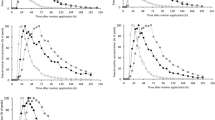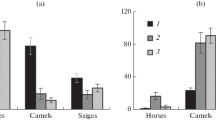Summary
Ruminants are unevenly distributed across the range of body sizes observed in herbivorous mammals; among extant East African species they predominate, in numbers and species richness, in the medium body sizes (10–600 kg). The small and the large species are all hind-gut fermenters. Some medium-sized hind-gut fermenters, equid perissodactyls, coexist with the grazing ruminants, principally bovid artiodactyls, in grassland ecosystems. These patterns have been explained by two complementary models based on differences between the digestive physiology of ruminants and hind-gut fermenters. The Demment and Van Soest (1985) model accounts for the absence of ruminants among the small and large species, while the Bell/Janis/Foose model accounts both for the predominance of ruminants, and their co-existence with equids among the medium-sized species (Bell 1971; Janis 1976; Foose 1982). The latter model assumes that the rumen is competitively superior to the hind-gut system on medium quality forages, and that hind-gut fermenters persist because of their ability to eat more, and thus to extract more nutrients per day from high fibre, low quality forages. Data presented here demonstrate that compared to similarly sized grazing ruminants (bovids), hind-gut fermenters (equids) have higher rates of food intake which more than compensate for their lesser ability to digest plant material. As a consequence equids extract more nutrients per day than bovids not only from low quality foods, but from the whole range of forages eaten by animals of this size. Neither of the current nutritional models, nor refinements of them satisfactorily explain the preponderance of the bovids among medium-sized ungulates; alternative hypotheses are presented.
Similar content being viewed by others
References
AOAC (1970) Official Methods of Analysis. Association of Official Agricultural Chemists, Washington DC
A.R.C. (1965) The nutrient requirements of farm livestock No 2 Ruminants. Agricultural Research Council, London
Alexander F (1946) The rate of passage of food residue through the digestive tract of the horse. J Comp Pathol 56: 226
Arnold GW, Dudzinski ML (1978) Ethology of free living domestic animals. Elsevier, Amsterdam
Balch CC, Campling RW (1965) Rate of passage of digesta through the ruminant digestive tract. In: Dougherty RW (ed) Physiology of digestion in the ruminant. Butterworths, Washington, pp 108–123
Bell RHV (1971) A grazing system in the Serengeti. Sci Am 225: 86–93
Boulot S (1987) L'ingestion chez la jument. Etude au cours du cycle gestation-lactation; implications nutritionnelles et metaboliques. PhD thesis, University of Rennes, France
Campling RC, Lean IJ (1983) Food characteristics that limit voluntary intake. In: Rook JAF, Thomas PC (eds) Nutritional physiology of farm animals. Longman, London, pp 457–475
Cumming DHM (1982) The influence of large herbivores on savanna structure in Africa. In: Huntley BJ, Walker BH (eds) The ecology of tropical savannas. Ecological Studies, vol 42. Springer, Berlin, pp 217–245
Darlington JM, Hershberger TV (1968) Effect of forage maturity on digestibility, intake and nutritive value of alfalfa, timothy and orchard grass by equine. J Anim Sci 21: 1572–1576
Demment MW (1983) Feeding ecology and evolution of body size of baboons. Afr J Ecol 21: 219–233
Demment MW, Van Soest PJ (1982) Body size, digestive capacity, and feeding strategies of herbivores. Winrock International, Morrilton, Arkansas
Demment MW, Van Soest PJ (1985) A nutritional explanation for body-size patterns of ruminant and nonruminant herbivores. Am Nat 125: 641–672
Duncan P (1985) Time-budgets of Camargue horses. III. Environmental influences. Behaviour 92: 188–208
Foose TJ (1978) Digestion in wild species of ruminant versus nonruminant ungulates. American Association of Zoological Parks and Aquaria 1978 Conf Proc: 74–84
Foose TJ (1982) Trophic strategies of ruminant versus nonruminant ungulates. PhD dissertation, University of Chicago
Fonnesbeck PV (1968) Digestion of soluble and fibrous carbohydrates of forage by horses. J Anim Sci 27:1306–1344
Fonnesbeck PV (1969) Partitioning the nutrients of forages for horses. J Anim Sci 28:624–663
Frecland WJ, Janzen DH (1974) Strategies in herbivory by mammals: the role of plant secondary compounds. Am Nat 108:269–289
Gakahu CG (1982) Feeding strategies of the plains zebra, Equus quagga burchelli, in the Amboseli ecosystem. PhD thesis, University of Nairobi, Kenya
Georgiadis NJ, McNaughton SJ (1988) Interactions between grazers and a cyanogenic grass, Cynodon plectostachyus. Oikos 51:343–350
Goering HK, Van Soest PJ (1970) Forage fiber analyses (apparatus, reagents, procedures and some applications). United States Department of Agriculture Research Station, Agricultural Handbook No 379
Gordon IJ (1989) Vegetation community selection by ungulates on the Isle of Rhum I. The food supply. J Appl Ecol 26(1) 35–52
Gwynne MD, Bell RHV (1968) Selection of vegetation components by grazing ungulates in the Serengeti National Park. Nature (Lond) 220:390–393
Hintz HF (1969) Review article: comparison of digestion coefficients obtained with cattle, sheep, rabbits and horses. Veterinarian 6:45–55
Janis CM (1976) The evolutionary strategy of the Equidae and the origins of rumen and cecal digestion. Evolution 30:757–774
Janis CM (1989) A climatic explanation for patterns of evolutionary diversity in ungulate mammals. Palaeontology (Lond) 32:463–481
Jarrige R, Tisserand JL (1984) Metabolism, besoins et alimentation azotes du cheval. In: Jarrige R, Martin-Rosset W (eds) Le Cheval. Reproduction, selection, alimentation exploitation. INRA, Paris pp 277–302
Johnson GE, Borman MM, Rittenhouse LR (1982) Intake, apparent utilisation and rate of digestion in mares and cows. Proc Western Section. Am Soc Anim Sci 33:3
Kruuk H (1972) The spotted hyaena. A study of predation and social behavior University of Chicago Press, Chicago
Krysl LJ, Sowell BF, Hubbert ME, Plumb GE, Jewett TK, Smith MA Waggoner JW (1984) Horses and cattle grazing in the Wyoming Red Desert II Dietary quality. J Range Manage 37(3):252–6
Langer P (1986) Large mammalian herbivores in tropical forests with either hindgut- or forestomach-fermentation. Z Säugetier 51:173–187
Langer P (1987) Evolutionary patterns of Perissodactyla and Artiodactyla (Mammalia) with different types of digestion. Z Syst Evolution-forsch 25:212–236
Laut JE, Houpt KA, Hintz HF, Houpt T (1985) The effect of caloric dilution on meal patterns and food intake of ponies. Physiol Behav 35:549–554
Levin DA (1976) The chemical defences of plants to pathogens and herbivores. Ann Rev Ecol Syst 7:121–160
Martin-Rosset W, Andrieu J, Vermorel M, Dulphy J-P (1984) Valeur nutritive des aliments pour le cheval. In: Jarrige R, Martin-Rosset W (eds) Le cheval. Reproduction, selection, alimentation, exploitation. INRA, Paris, pp 209–238
Moir RJ (1968) Handbook of physiology, section 6. (Alimentary canal. Vol V, ch 126). American Physiology Society, Washington
National Research Council (1984) Nutrient requirements of beef cattle. National Academy Press, Washington
Ngethe JC (1976) Preference and daily intake of 5 East African grasses by zebra. J Range Manage 29:510–511
Owaga ML (1975) The feeding ecology of wildebeest and zebra in Athi-Kaputei plains. E Afr J Ecol 13:375–383
Owen-Smith N (1982) Factors influencing the consumption of plant products by herbivores. In: Huntley BJ, Walker BH (eds) The ecology of tropical savannas. (Ecological Studies, Vol 42). Springer, Berlin, pp 359–404
Owen-Smith N (1985) Niche separation among African ungulates. In: Vrba ES (ed) Species and speciation. Transvaal Museum Monograph No 4, Transvaal Museum, Pretoria, pp 167–171
Putman R (1986) Grazing in temperate ecosystems: large herbivores and the ecology of the New Forest Croom Helm, London, pp 210
Rohweder DA, Jorgenson N, Barnes KF (1983) Proposed hay standards based on laboratory analyses for evaluating forage quality. In: Smith JA, Hays VW (eds) Proc IVth Int Grassld Congr, pp 534–538
Schaller GB (1972) The Serengeti lion. A study of predator-prey selations University of Chicago Press, Chicago
Simpson GG (1953) The major features of evolution. University of Columbia Press, New York
Sinclair ARE, Norton-Griffiths M (1982) Does competition or facilitation regulate migrant ungulate populations in the Serengeti? A test of hypotheses. Oecologia 53:364–369
Sokal RR, Rohlf FJ (1981) Biometry (2nd ed). WH Freeman and Co, New York
Stanley SM (1974) Effects of competition on rates of evolution with special reference to bivalve molluscs and mammals. Syst Zool 22:486–506
Van Soest PJ (1982) Nutritional ecology of the ruminants. O and B Books, Corvallis, Oregon
Van Soest PJ, Jeraci J, Foose T, Wrick K, Ehle F (1983) Comparative fermentation of fibre in man and other animals. Bull N Z Royal Soc 20:75–80
Van Valen L (1971) Adaptive zones and the orders of mammals. Evolution 25:420–428
Vander Noot GW, Gilbreath EB (1970) Comparative digestibility of components of forages by geldings and steers. J Anim Sci 31:351–355
Vermorel M (1978) Utilisation energetique des produits terminaux de la digestion. In: Jarrige R (ed) Alimentation des ruminants. Institut National de la Recherche Agronomique, 7800 Versailles, France, pp 47–88
Vermorel M, Jarrige R, Martin-Rosset W (1984) Metabolisme et besoins du cheval. Le systeme des UFC. In: Jarrige R, Martin-Rosset W (eds) Le cheval. Reproduction, selection, alimentation, exploitation. INRA, Paris, pp 239–276
White TCR (1978) The importance of a relative shortage of food in animal ecology. Oecologia 33:71–78
Author information
Authors and Affiliations
Rights and permissions
About this article
Cite this article
Duncan, P., Foose, T.J., Gordon, I.J. et al. Comparative nutrient extraction from forages by grazing bovids and equids: a test of the nutritional model of equid/bovid competition and coexistence. Oecologia 84, 411–418 (1990). https://doi.org/10.1007/BF00329768
Received:
Accepted:
Issue Date:
DOI: https://doi.org/10.1007/BF00329768




